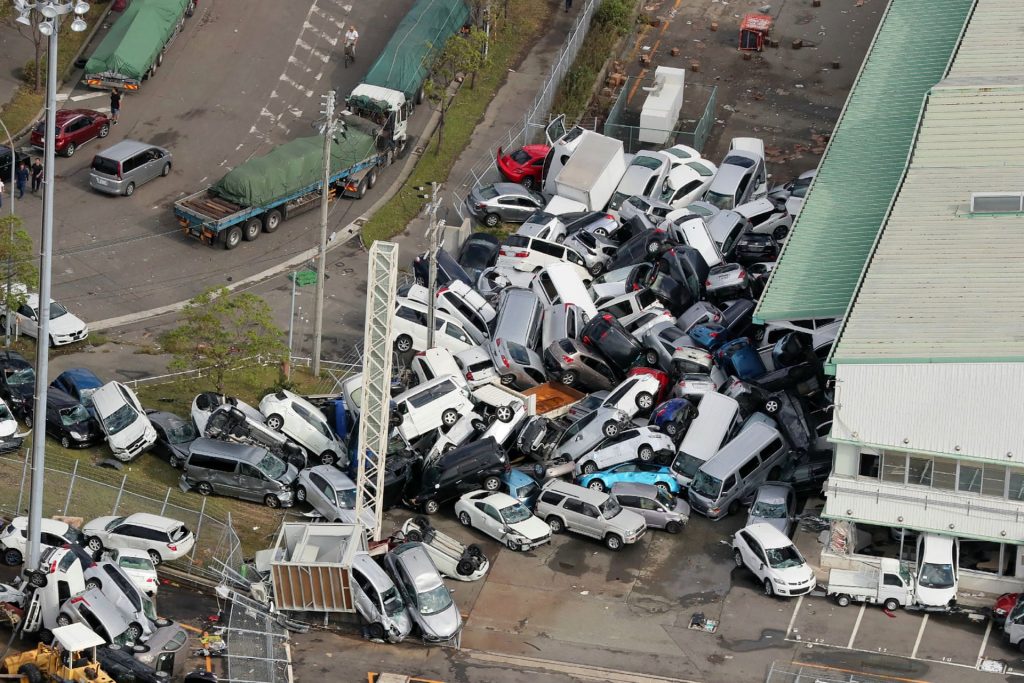Typhoon Jebi! Japan was hit by strongest storm in 25 years on September 4, 2018, as the dangerous and violent storm slammed into western Japan, inundating the region’s main international airport, blowing a tanker into a bridge, disrupting land and air travel and leaving thousands stranded. The powerful typhoon has already killed 11 people.

Local media reported that seven people died and more than 100 others were injured when Typhoon Jebi caused violent winds in the west of the country. The storm is the strongest to hit the country in 25 years.
According to public broadcaster NHK, the casualties included a 71-year-old man who was killed in western Shiga prefecture after being trapped under a warehouse that collapsed in strong wind. NHK said 164 people had suffered mostly minor injuries.

Several people were injured at Kyoto station when part of a glass ceiling collapsed, according to police. A number of vehicles were blown on to their sides on a motorway, while a truck narrowly escaped being swept off a bridge connecting the island of Shikoku and the main Japanese island of Honshu.
Television networks showed dramatic footage of a 2,591-tonne tanker that collided with the side of a bridge linking the mainland with Kansai International airport, which stands on an artificial island in Osaka Bay. The tanker and bridge were damaged but the ship’s crew were unhurt. The airport’s runway and the basement floor of a terminal building were flooded, according to local authorities.

The damage to the bridge left the airport cut off from the mainland and stranded around 3,000 people there, an official said. The winds at Kansai International Airport were insane:
TV stations also showed footage of a 100m (328 ft) tall ferris wheel in Osaka spinning furiously in the strong wind despite being switched off. “I’ve never seen such a thing,” a 19-year-old man at the scene told NHK.
Evacuation advisories were issued for 1.19 million people, along with a stronger but non-mandatory evacuation order for a further 16,000 people, as the wind and rain began to intensify on Tuesday afternoon. Most of those advised to leave their homes and head to 1,500 temporary shelters were in the western port city of Kobe.

Here a gust of wind overturns a car in Osaka:
The meteorological agency said in a televised warning that the system could trigger violent winds, landslides and flooding in southern and south-western parts of the archipelago, as well as high tides, lightning and tornadoes.
The prime minister, Shinzō Abe, urged residents to “evacuate early” and cancelled a planned trip to Kyushu in Japan’s south-west so he could oversee the government’s response.
And the railway station was down:
While the typhoon is not expected to make a direct hit on Tokyo, its path will take it over the cities of Osaka and Kyoto before it heads out to sea, according to the meteorological agency.
The agency added that if Jebi maintained its current strength of 216kmh (135mph) it would be the first “very strong typhoon” to strike Japan since 1993, when a powerful typhoon left 48 people dead or missing. “It is possible that [Jebi] will make landfall while maintaining its extreme strength,” said Ryuta Kurora, the agency’s chief forecaster.

In the hours before the storm made landfall, some areas were already experiencing violent storms ”and the storms will get stronger and stronger”, he added.
The typhoon comes soon after parts of Japan were hit by torrential rains in July that killed more than 200 people.

One resident of Osaka said her house was shaking and the lights were flickering on and off. People in nearby Kobe said on social media that the wind was shaking their apartment buildings and ripping branches off trees.
As it made its way north from the southern island of Okinawa, Jebi was already causing widespread disruption to flights and public transport. More than 700 domestic and international flights were cancelled, along with scores of ferry and train services, the public broadcaster NHK said.
Bullet train services were reduced, while schools closed for the day.

The meteorological agency said Jebi was expected to pass over the Sea of Japan by late Tuesday and to have weakened to an extra-tropical cyclone by Wednesday morning.
Follow us: Facebook and Twitter
The Guardian – Typhoon Jebi: Japan hit by strongest storm of 25 years












[…] Source: Typhoon Jebi is Japan’s strongest storm in 25 years: At least eleven dead, 100s of injured, fl… […]